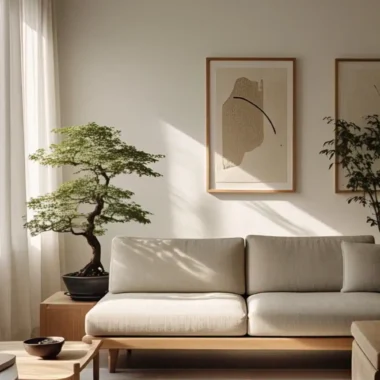Looking to bring authenticity and calm into your living space? Enter the Wabi-Sabi table — a beautiful expression of rustic refinement and imperfect charm. In a world obsessed with perfection, Wabi-Sabi invites us to embrace the beauty of flaws, wear, and simplicity.
If you’re curious about how to weave this aesthetic into your home (and why you should), you’re in the right place. Let’s dive in!
















Understanding Wabi-Sabi Aesthetic
The Philosophy of Wabi-Sabi
First things first—what exactly is Wabi-Sabi?
Originating from Japanese philosophy, Wabi-Sabi is all about finding beauty in imperfection, impermanence, and natural simplicity. Think about a cracked ceramic bowl or an aged wooden beam. Instead of hiding these signs of wear, Wabi-Sabi celebrates them.
Why Wabi-Sabi Matters in Modern Interiors
In today’s fast-paced, hyper-digital world, Wabi-Sabi provides a refreshing counterbalance.
By incorporating elements that show age and authenticity, this aesthetic fosters mindfulness and a deeper connection with your surroundings. Your home becomes a haven — not a showroom.
What Is a Wabi-Sabi Table?
Key Characteristics of a Wabi-Sabi Table
Key characteristics of Wabi-Sabi revolve around embracing imperfection, impermanence, and simplicity. This philosophy values natural materials, asymmetry, weathered textures, muted colors, and the beauty found in age and authenticity. Rather than chasing flawless beauty, Wabi-Sabi invites us to slow down, appreciate subtle details, and find grace in the imperfect and unfinished.
So, where does the Wabi-Sabi table come in?
A Wabi-Sabi table typically highlights:
- Natural materials (wood, stone)
- Organic shapes (irregular edges, handmade feel)
- Visible imperfections (knots, cracks, wear marks)
- Subdued color palette (earthy tones, muted shades)
It isn’t polished to perfection. Instead, its character tells a story — of nature, time, and craftsmanship.
Materials That Define Rustic Refinement
Let’s get a little more specific. Materials are key to achieving that rustic refinement vibe.
Reclaimed Wood
Nothing says Wabi-Sabi like a weathered, reclaimed wood tabletop. The knots, grain patterns, and color variations reflect the passage of time — adding warmth and depth to any room.
Stone and Ceramic Elements
Stone and ceramic surfaces — whether tabletops or inlays — bring an earthy groundedness. Slight irregularities, subtle color shifts, and natural textures amplify the Wabi-Sabi charm.
Natural Textures and Finishes
Forget glossy or synthetic finishes. Look for matte, unfinished, or lightly oiled surfaces that showcase the material’s inherent qualities.
How to Style a Wabi-Sabi Table
Less Is More: Minimalist Approach
When styling a Wabi-Sabi table, the mantra is simple: less is more.
Leave plenty of negative space. Choose a few meaningful objects — perhaps a handmade ceramic bowl, a sprig of dried flowers, or a simple linen runner.
Integrating With Modern Decor
To integrate Wabi-Sabi tables into modern decor, focus on contrast and balance. Pair rustic, aged wood with sleek modern chairs or minimalist lighting. Keep the color palette neutral and earthy, and let the table be the organic centerpiece in a clean-lined space. Choose accessories like handmade ceramics or natural textiles that echo the table’s textures, without overwhelming it.
This creates a calming fusion of old-world charm and contemporary clarity.
Popular Design Variations
Popular design variations of Wabi-Sabi tables often highlight natural materials and handmade aesthetics, with each style embracing uniqueness and imperfection:
- Live-edge tables: Featuring raw, uneven wood edges for organic appeal.
- Low-profile tables: Inspired by traditional Japanese dining, simple and grounded.
- Reclaimed wood tables: Made from salvaged timber with visible wear and grain.
- Mixed-material tables: Combining wood with stone, metal, or clay for contrast.
- Asymmetrical or irregular shapes: Prioritizing flow and spontaneity over symmetry.
Finding or Creating Your Own Wabi-Sabi Table
Where to Buy Authentic Wabi-Sabi Furniture
Authentic Wabi-Sabi furniture is sometimes hard to find — but that’s part of the fun! Here’s where to look:
- Artisan workshops specializing in handmade furniture
- Antique shops and flea markets (embrace those imperfections!)
- Boutique home brands focusing on sustainable design
Pro tip: Look for items described as “reclaimed,” “handmade,” or “organic.”
DIY Wabi-Sabi Table Ideas
Feeling crafty? You can also create your own Wabi-Sabi table:
- Source reclaimed wood or an old piece of furniture.
- Sand lightly, but don’t erase signs of wear.
- Finish with natural oil or matte wax — avoid glossy varnish.
- Embrace imperfections — don’t “fix” every crack!
Common Mistakes to Avoid
When adopting the Wabi-Sabi aesthetic, it’s easy to slip into a few traps:
- Over-styling — resist the urge to overload your table with decor.
- Using synthetic materials — stick with natural, authentic materials.
- Forcing imperfections — let them occur naturally; don’t fake them.
Remember, Wabi-Sabi is about authenticity, not creating a staged “imperfect” look.
Benefits of Integrating Wabi-Sabi in Home Design
Cultivating Mindfulness
A Wabi-Sabi table encourages a slower, more mindful approach to life. Sitting at a table that tells a story makes everyday moments — from sipping tea to journaling — feel more intentional.
Promoting Sustainability
Choosing reclaimed and handmade materials means embracing sustainability. You’re giving new life to old materials and supporting small-scale artisans — a win-win!
A Wabi-Sabi table isn’t just a piece of furniture — it’s a philosophy in wood and stone. In a world of mass-produced perfection, it whispers a different message:
“Be real. Be simple. Be present.”
So whether you’re buying or building one, embrace the rustic refinement that Wabi-Sabi brings into your home. Trust me — your space (and your soul) will thank you.





